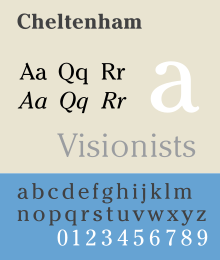
Back Cheltenham (Schriftart) German Cheltenham (police de caractères) French Cheltenham (lettertype) Dutch
 | |
| Category | Serif |
|---|---|
| Classification | old style |
| Designer(s) | Bertram Grosvenor Goodhue Ingalls Kimball |
| Foundry | American Type Founders |
| Date released | 1903 |
| Shown here | ITC Cheltenham |
Cheltenham is a typeface for display use designed in 1896 by architect Bertram Goodhue and Ingalls Kimball, director of the Cheltenham Press. The original drawings were known as Boston Old Style and were made about 14" high. These drawings were then turned over to Morris Fuller Benton at American Type Founders (ATF) who developed it into a final design. Trial cuttings were made as early as 1899 but the face was not complete until 1902. The face was patented by Kimball in 1904. Later the basic face was spun out into an extensive type family by Morris Fuller Benton.[1]
Cheltenham is not based on a single historical model, and shows influences of the Arts and Crafts Movement. Originally intended as a text face, "Chelt" became hugely successful as the "king of the display faces." Part of the face's huge popularity is because, as it has elements of both an old style and transitional face, a Cheltenham headline complements virtually any body type.[2] The overwhelming popularity of the face for display purposes lasted until the advent of the geometric sans-serif typefaces of the 1930s.
- ^ Some sources say that Joseph W. Phinney, head of ATF's design department, and not Benton, was responsible for finishing the type. See Mac McGrew, American Metal Typefaces of the Twentieth Century, Oak Knoll Books, New Castle Delaware, 1993, ISBN 0-938768-34-4, pp. 84 - 89.
- ^ Hlasta, Stanley C., Printing Types & How to Use Them, Carnegie Press, Pittsburgh, Pennsylvania, 1950, p. 217.